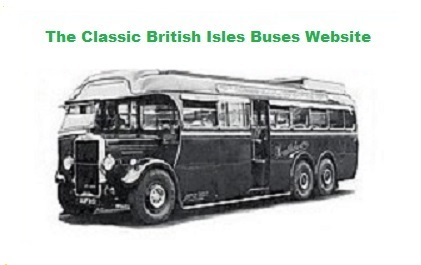

The Classic British Isles Buses Website
Vintage bus tickets (by Dick Gilbert)
Last updated 30 August 2024
Email Events diary Past events list Classified ads Links to other websites Classic U.K. Buses Classic Irish Buses Classic Manx Buses
This page is about British bus tickets from the 1950s and 60s, and shows some bits and pieces from a collection I put together at the time. I hope it jogs some memories of those days for any visitors who remember such things.
LONDON TRANSPORT
Around 1958 (like schoolkids sometimes did) I started collecting bus tickets. Sad, really. Well, it was a cheap occupation. Since I lived in Croydon at the time, the London Transport examples are the most numerous. Remarkably, I still have them, and here are a few samples.
All are, of course, pre-decimal currency and most are of the Bell Punch type, a style which was shortly to be eliminated from London's streets, unknown to me at the time.
The 1 penny tickets (example in the row below) were the first to disappear, presumably due to inflation! Matt Wharmby reminded me that schoolkids used to add up the numbers on the top of each ticket, and a total of 21 was considered lucky!

The next row shows some higher values, but all these were standard issue on London (red) central area buses in the late 1950s. The exception is the 10d (ten old pence for our younger readers - if any get this far !) which is actually a Sunday morning cheap single, and had a non-standard and somewhat garish colour scheme. The 8d ticket is a lucky one! Matt also told me that, in some young circles, the letters at the top were also significant as fortune tellers. Apparently the letters could be the initials of the person you were going to marry and, if it was a lucky ticket as well, you were supposed to give the ticket to the person concerned. Debbie Underwood - this is your big moment!

The row below (6d to 1/2d), are all from Country area (green) buses, which had far more colourful designs, and larger fare numbers. In fact they were usually for larger fares as well, because folk tended to travel further on country buses. The 10d ticket is another lucky one...

The little miscellany below contains a variety of London Transport oddments, starting with the Red Rover ticket. This enabled the holder to travel anywhere on central area buses, trolleybuses and the underground for a fixed fee on one day only. Child - under 14 years of age it says, but I wasn't! I was out seeking the last Leyland TD single deckers that day.
(Peter Webb emailed in March 2014 to say: "Excellent site, brought back many memories of my younger days collecting bus numbers in and around Walthamstow with my Ian Allan book. Just one small point - in the section about tickets, you mention the Red Rover ticket. Please note this was for buses only, to use the Underground as well you had to get a twin rover ticket". Thanks for pointing that out, Peter.)
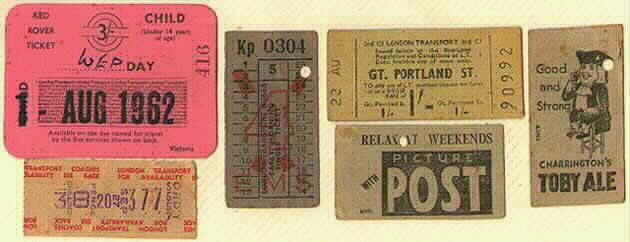
Below it is a 3/8d Green Line coach ticket from a new-fangled Setright machine. The 4d ticket is an early morning single, a cheap rate for early risers. On the right is a 1/- Underground ticket, marked 3rd class (was there ever a 1st class on the underground? Well, Paul Kirkup mailed me to say that there certainly was on the Metropolitan Railway, the underground's predecessor pre-war). Finally, there were often advertisements on the back of bus tickets, and here are a couple of period pieces.
EASTBOURNE CORPORATION
In 1959 my family moved to Eastbourne, so it was natural that my collection would include a good selection from that seaside town. Eastbourne Corporation bus tickets were slightly larger than those in London, and very colourful.
I was fortunate to have been given a complete set of mint tickets by the Corporation for something - I can't remember what. Maybe it was a bribe to stop me hanging around their garage. Anyway, the result is that most of the tickets below have no hole where the Bell Punch machine would normally have perforated them.
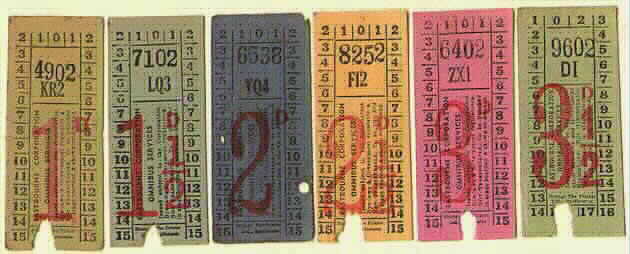
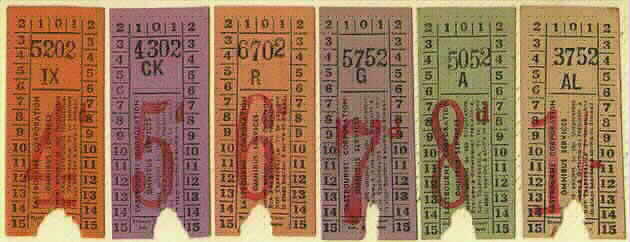
Smart, aren't they? Return tickets were all striped, and had the unusual attribute of showing on them the round-trip route options for which they were valid. The complete set is shown below, including another unusual feature in the shape of an exchange ticket. This was given to the passenger (at no charge) in exchange for his return ticket on the return journey. Does anyone know of this system being used elsewhere?
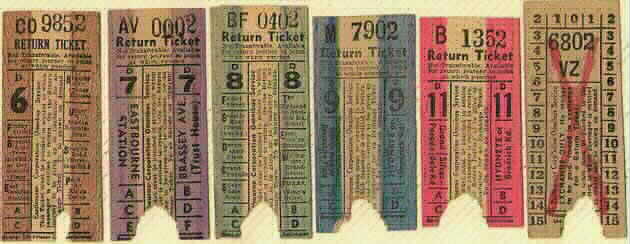
Below are some Eastbourne oddments. The workmen's returns on the left had to be issued before 8:30 in the morning. The school tickets were supplied in booklets (I still have one) if you lived more than a certain distance from your school. Unused ones were a form of currency among Eastbourne kids. The ticket on the right is probably the most rare. It is quite genuine and dates (I think) from the 1930s, or even earlier.
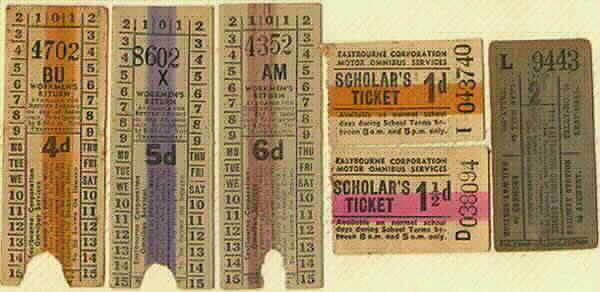
Finally, to complete the set, here is the vast town and shore ticket. For 2 shillings you could travel anywhere around the town as much as you liked, but only for half a day. It's not easy to imagine a circumstance in which this was a good deal.
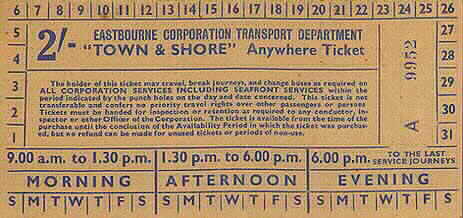
SOUTHERN SELECTION
Brighton Corporation (on the left) used Bell Punch tickets until around 1960, when they switched to new machines and Olley tickets. Brighton Hove and District (on the right) used identical Bell Punch tickets, but switched over to Setright machines (extreme right).

Aldershot and District used thick card tickets, including the exotic return tickets of which one is shown below. They were validated on both journeys, once at each end. The mauve single ticket has a dull pink 1/2 (half) printed on it (if you can't see it, you'll have to believe me !) and was for half pennies. Thus, if you wanted a one penny fare you got a white ticket stamped one, but if you wanted a penny halfpenny fare (one and a half old pence), you got a mauve ticket stamped one.
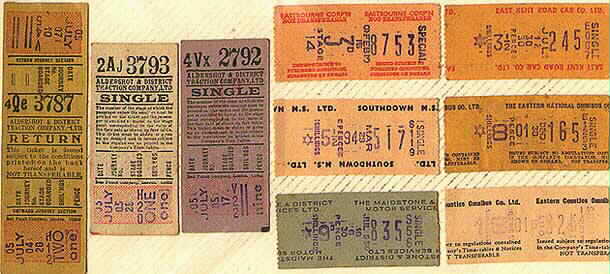
Eventually, though, Aldershot went over to Setright machines, as did many other southern operators. Shown above right are examples from Eastbourne, Southdown, Maidstone and District, East Kent, Eastern National and Eastern Counties.
These tickets may look modern to the wrinklies amongst us, but remember that they are all pre-decimal currency, and at least 50 years old.
MIDLANDS SELECTION
The Setright machine was common all over Britain in the early 1960s, and the examples below left are from Trent, Ribble, East Midland, and Midland Red, whose tickets were pink on the back. Nottingham avoided this trend however, as the specimens below right show.

NORTHERN AND SCOTTISH SELECTION
On the left are examples from Manchester (MCTD). The LCPT (centre, top) is from Liverpool. Below it is an example from the delightfully-named Stalybridge, Hyde, Mossley and Dukinfield Joint Transport and Electricity Board - a collector's item I'm sure. Finally, up to Scotland, and some samples from Dundee Corporation, and Alexanders. Walter Alexander and Sons had several divisions and this one, I think, was Fife, which accounts for the (F.) in the name. I was quite pleased to have this one, because it was a bit of a rarity for a sassenach.
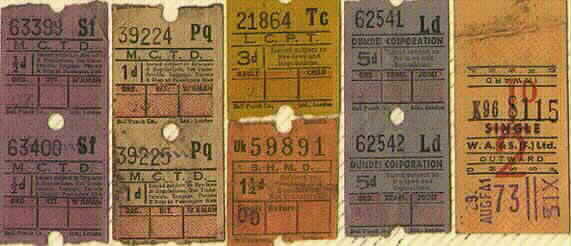
Well, that's a little sample from my collection and I hope you enjoyed the ride. For those with a deeper interest in the subject, contact the Transport Ticket Society.
And here is an amazing list of all the users of the TIM ticket machine and also the Setright ticket machine, and images of the tickets they issued.
Email Events diary Past events list Classified ads Links to other websites Classic U.K. Buses Classic Irish Buses Classic Manx Buses